Chat and Mail
This chapter only focuses on the configuration needed to login an agent and handle calls and emails with b+s Connects for Oracle Service Cloud. It outlines the concept of transporting data from the customer, through Cisco's routing engine into the Harmony Media Bar and the required configuration steps in the individual components
Concept variable mapping
In order to transport data from the customer through UCCE into the Harmony Media Bar in the Oracle Service Cloud, the data has to be mapped to a dedicated Peripheral, or ECC-Variable (Example: EmailAddresse=pv2). To be able to provide the same piece of information to the Harmony Media Bar, this data needs to be mapped back into the Harmony Agent Adapter initialization file (e.g. Map(0)=Email_Address=pv2 in [Gate_harmony\EmailVariableMapping]-section).
The following graphic illustrates this data stream from the Queue Adapter, via the Harmony Routing Adapter and Cisco CCE into the Harmony Agent Adapter and the Harmony Media Bar.
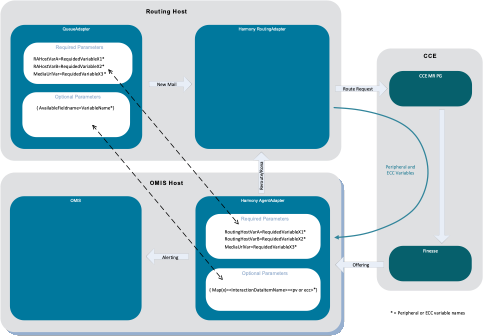
By default, the following variables are mapped in the Queue Adapter and the Harmony Agent Adapter initialization file:
- QueueAdapter attached data (email):
EmailAddress=pv2,ReferenceNumber=pv3,Product=pv4,Category=pv5 - QueueAdapter attached data (chat):
EmailAddress=pv2,Product=pv4,Category=pv5 - AgentAdapter initialization file:
[Gate_harmony\ChatVariableMapping] Map(0)=Email_Address=pv2
[Gate_harmony\EmailVariableMapping] Map(0)=Email_Address=pv2 Map(1)=ReferenceNumber=pv3
Queue Adapter
To apply the QueueAdapter configuration, start the QueueAdapter manager. A shortcut to the application is created on the desktop during the installation process.
Site Interface settings
The Site Interface(s) define the connection to the Oracle Service Cloud. This instance has to be requested from Oracle. The credentials of the Oracle Service Cloud instance are required in the following chapters.
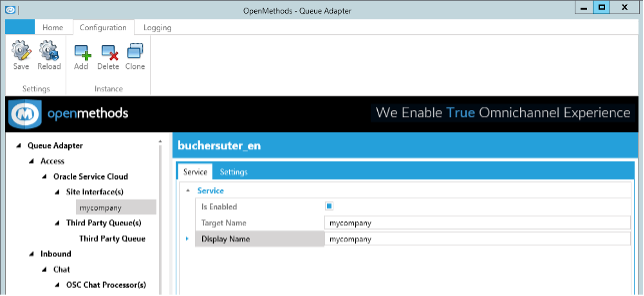
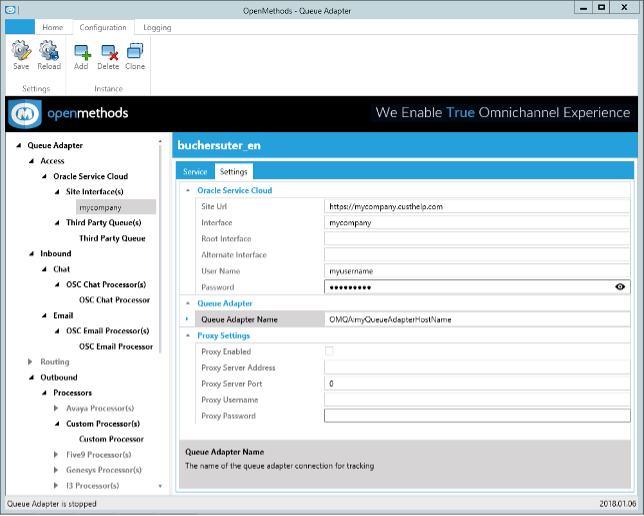
Site Url
- Oracle Service Cloud Url to connect to
- Example:
https://mycompany.custhelp.com
Target Name, Display Name and Interface
- Represent the Name of the Oracle Service Cloud's interface
- Example:
mycompany
User name, password
- The service cloud user to authenticate the Queue Adapter
- Example:
myusername - Default:
connect
Queue Adapter name
- The name of the host where queue adapter is deployed
- Example:
OMQA:myQueueAdapterHostName
Third party queues settings
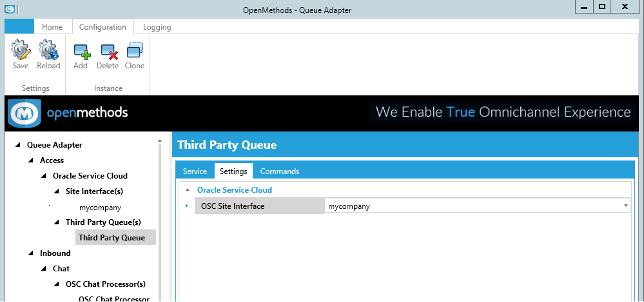
In Third Party Queue settings / OSC Site Interface, select the created site interface
OSC chat processor settings
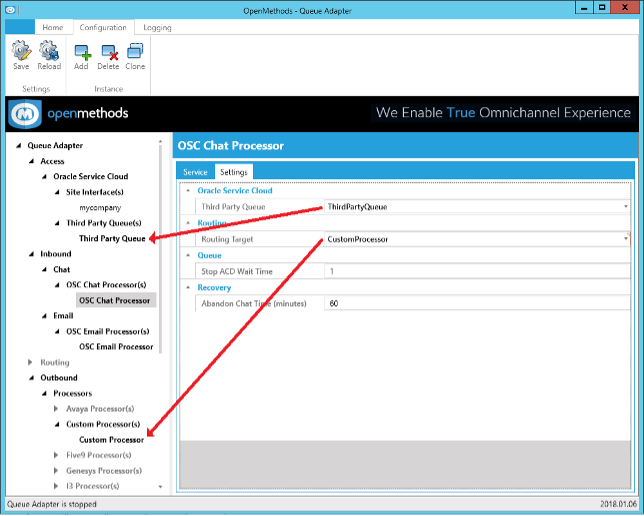
In OSC Chat Processor settings the Third Party Queue source item is linked to the Custom Processor target item.
OSC Email processor settings
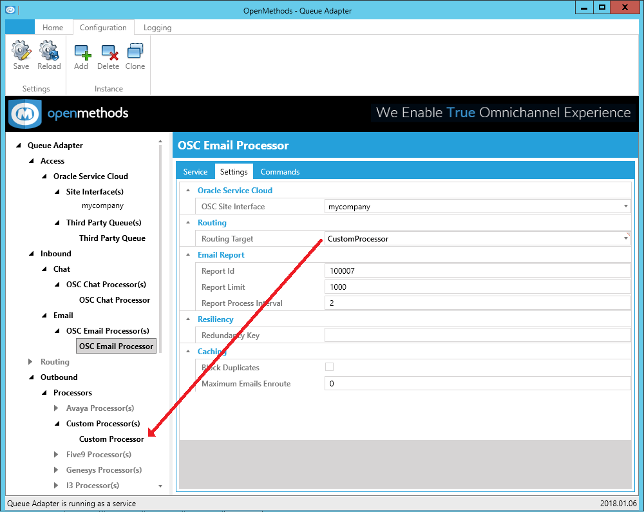
In OSC Mail Processor settings the Queue source item is linked to the Custom Processor target item.
Custom Processor settings
In the Customer Processor settings the bsMediaRoutingPlugin.dll has to be referenced. This plugin establishes the connection to the Harmony RoutingAdapter. Additionally, all the bsMediaRoutingPlugin.dll related configuration parameters are set within the Custom Processor settings. All routing relevant data can be mapped to dedicated Peripheral and Extended Call Context Variables by configuring them appropriately within the Configuration Pairs and Attached Data fields. The mapped variable's data is then available for Harmony Agent Adapter as well as for the Harmony MediaBar. The following variables are available:
- PV1, PV2, PV3,...,PV10
- ECC.user.
<variablename>(any ECC.user configured variable in CCE)
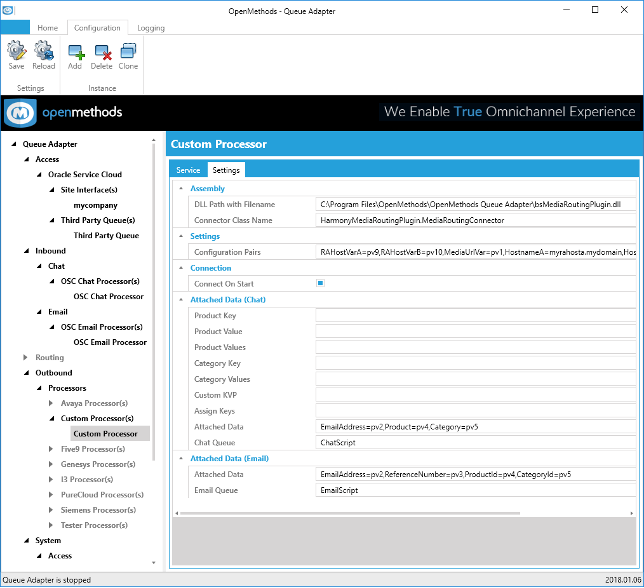
DLL Path with Filename
- The path and filename of the plugin used for Custom Routing which must point to the
bsMediaRoutingPlugin.dll
Connector Class Name
- The class name of the plugin has to be used:
HarmonyMediaRouting-Plugin.MediaRoutingConnector
Configuration Pairs
- Specific configuration values for the custom DLL as a comma-delimited list of key-value pairs
- The MediaRoutingPlugin uses the following required configuration keys:
- HostnameA: Hostname from Harmony Routing Adapter host side A
- HostnameB: Hostname from Harmony Routing Adapter host side B
- Port: Harmony Routing Adapter Service Port
- IsEncrypted: “true” for encrypted connection to RoutingAdapter or “false” for unencrypted connection.
- RAHostVarA: Call or ECC Variable which contains the Hostname
- RAHostVarB: Call or ECC Variable which contains the Hostname - if the containing data in RAHostVarA and RAHostVarB does not exceed the available single variable space, these two values can be mapped onto the same variable.
- MediaUrlVar: Call or ECC Variable which contains the Media Url
- Example
RAHost-Va-rA=pv9,RAHostVarB=pv10,MediaUrlVar=pv1,HostnameA=myrahosta.mydomain,HostnameB=myrahostb.mydomain,Port=8092,IsEncrypted=false
Attached Data (Chat)
- These are the fields that are sent to the custom DLL for a chat. All fields can be mapped to a Call or ECC-Variable
- Required
EmailAdresse
- Optional
Question,ChatId,FirstName,LastName,Product,ProductId,Category,CategoryId,Queue,QueueId,Source,SequenceNumber,TimeCreated,Interface,Machine,omQAName,omQAVersion
ProductId and CategoryId contains the localized product name, not the Id of the product
- Example
EmailAddress=pv2,Product=pv4,Category=pv5
Chat Queue
- Add the name of the UCCE Script Selector used for routing chats here. If
Attached Data (Chat)contains a mapping to the fieldRoutingScript, it will be used as script selector. Otherwise this configuration value is used as the CCE Script Selector.
Attached Data (Email)
- These are the fields that are sent to the custom DLL for a mail.
- Required:
EmailAddressReferenceNumber
- Optional:
Subject,IncidentId,FirstName,LastName,Product,ProductId,Category,CategoryID,Queue,SourceLevel1,SourceLevel2,TimeCreated,Interface,Machine,omQAName,omQAVersion
ProductId and CategoryId contains the localized product name, not the Id of the product
- Custom fields (added by customer to report)
- Custom fields added to the “OpenMethods QueueAdapter Email Report” report will also be available here. The field name as it appears here is built from custom field column titles with the following rules:
- First letter and letters after spaces are set to upper case
- All other letters are set to lower case
- Spaces are removed
- Example: CustomFieldTitle -> Customfieldtitle, Custom field title -> Custom-FieldTitle
- Custom fields added to the “OpenMethods QueueAdapter Email Report” report will also be available here. The field name as it appears here is built from custom field column titles with the following rules:
- Example:
EmailAddress=pv2,ReferenceNumber=pv3,ProductId=pv4,CategoryId=pv5
Logging Manager Settings
In order that log messages from bsMediaRoutingPlugin.dll are written to the QueueAdapter log file, please activate the setting: Trace Listener Enabled.
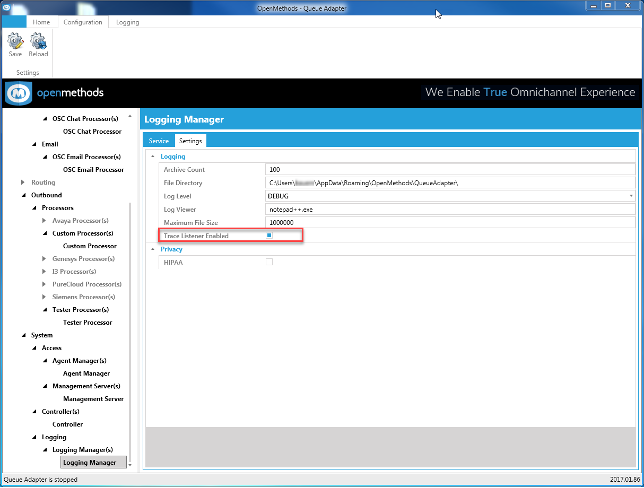
Harmony Routing Adapter
The following parameters are required to send media tasks received from the Queue Adapter to Cisco's Media Routing PIM.
[Gate_harmony]
LocalWebservice=net.tcp://localhost:8092/HarmonyRoutingAdapter
The LocalWebservice defines the entry point for the MediaRoutingPlugin .
[Gate_mri]
TcpPortNumber=7021
The TcpPortNumber defines the port on which Cisco's Media Routing PIM is connecting to.
[Gate_reroute]
ServerUri=http://0.0.0.0:8095
The ServiceUri is required for rejected tasks and for reroutes due to RONA.
For all available Harmony Routing Adapter configuration parameters, please consult Configuration File Harmony Routing Adapter
Harmony Agent Adapter
To enable Media channels and to map the corresponding configuration, parameters must be enabled in the Harmony Agent Initialization file:
[Gate_fin\MediaRouting]
;EmailDomain=5001
;ChatDomain=5002
[Gate_fin\MediaReroute]
RoutingHostVarA=pv9
RoutingHostVarB=pv10
;RonaTimeoutEmailInSeconds=30
;RonaTimeoutChatInSeconds=30
;RoutingHostPort=8095
;RoutingHostHttps=false
The values for EmailDomain and ChatDomain are commented out with a semicolon. Enable these values only if you use MediaRouting. They should not be enabled in a voice-only environment.